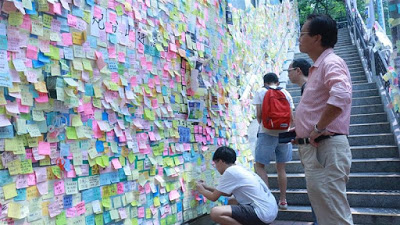When walls talk: Hong Kong protesters bring grievances to suburbs
 |
| Violet Law 24 July 2019 |
Protesters post sticky notes to spread message of dissent as walls have emerged as a new front of resistance.
In Hong Kong’s summer of dissent, even the walls are talking.
“Once you read the messages here, you’ll see so many people are in it together, showing support,” said Elmo Ho, 21, while running up and down the stairways in the Fortress Hill district of the city with a reel of clear tape to reinforce the hundreds of adhesive notes covering the walls.
Along with her 18-year-old sister, Ho was also looking for space to display a sheet of plastic crammed full of notes.
“What you see here feels very different from what you usually would read online,” Ho added.
In Hong Kong, nearly everyone owns a smartphone or two, and Facebook messaging and Whatsapp rule, but as anti-government protests have ratcheted up over the past few weeks, the humble sticky notes that have papered over pedestrian walkways, and in one case an 800 metre long tunnel, have emerged as a new front of resistance.
Locals call them “Lennon Walls”, after the walls of messages that appeared in Prague after John Lennon was shot dead in the early 1980s. People voice their demands and grievances on the small, colourful squares, while others share illustrations and doodles.
In Hong Kong, the first “Lennon Wall” appeared during the pro-democracy sit-in known as the Umbrella Movement in 2014 at the government headquarters, where protesters and their supporters posted messages as a way of cheering each other on.
Building momentum
When the wall was revived on the same spot in the current wave of protests only to be cleared out in early July, protesters clamoured online – an ironic twist in this hyper-wired society – to take this anachronistic means of protest to the neighbourhoods in order to build wider support for the cause.
Within days, more than 80 such “walls” had appeared on any expanse of vertical public space protesters saw fit.
“This time around the wall serves to sustain the movement’s momentum all over town,” said Ho, too modest to call herself the caretaker of the Fortress Hill wall. She recently finished a temporary sales job and is enjoying her last summer as a university student.
Over the past week, at least two incidents of arson and numerous fistfights have erupted in front of the walls in some parts of the city.
In mainland China, pasting writings on the wall has long been a popular form of protest.
In 1978 and 1989, manifestoes inked in brush calligraphy on large pieces of wafer-thin paper, called “big character posters,” were plastered on public walls, an early sign of dissent. The one in the heart of Peking University was known as the “democracy wall” and was renowned as a hub for protest.
The approach was adopted by university students in the then-British-ruled Hong Kong who dreamed of liberalising China and chafed at colonial rule. Till this day, democracy walls remain a fixture on college campuses in the territory and are seen as hotbeds of radical ideas.
Last September, scuffles broke out at Hong Kong’s Polytechnic University after students posted slogans demanding independence from China and university officials took over the campus wall.
The use of post-it notes also reflects the city’s office culture – and the limits of publicly available venues for people to air their discontent.
“This kind of direct democracy is being exercised on the surface of tiny memo notes,” wrote prominent culture critic Law Wing Sang in a recent newspaper column. “This is the latest innovation of Hong Kong’s resistance culture.”
‘Chance to vent’
Tang Shun returned to his neighbourhood of 30 years in Tai Po and was awed by the “Lennon Tunnel,” where every inch of the tiled surface has been papered over into a mosaic of messages.
Unlike Fortress Hill, a middle class area of old-style mid-rise apartments built on the hilly slopes, Tai Po, is across the harbour in the once-rural New Territories.
“This is the rare chance Hong Kong people get to vent, to say their piece,” said Tang, 36, a property manager. “They’ve been keeping it inside for far too long. Those who profess their support for the government don’t come out. If they’d come read the messages, they would see there’s no reason to support the officials.”
On Facebook, Tang said half his friends were still showing faith in the government.
“I’m scratching my head as we all grew up in a free society,” he said.
Ho was disappointed to discover that someone had splashed brown liquid over part of the wall that she had been working on.
“Even when you disagree with what others say, you should still respect their right to speak,” she said.
The two sisters’ mother has brought over stacks of post-it notes to help them, although she has yet to contribute a message herself.
Ho’s was among the first few: “We’ll act in lockstep. Stay united.” In ballpoint pen on the most common colour of pale yellow. She can still find it amid the long train of messages snaking all the way up the railings.
Ho shrugged at the thought of the wall being cleared out. “We’ll put it right back up,” she said. “This is a chapter of Hong Kong’s history; a show of people power.”


